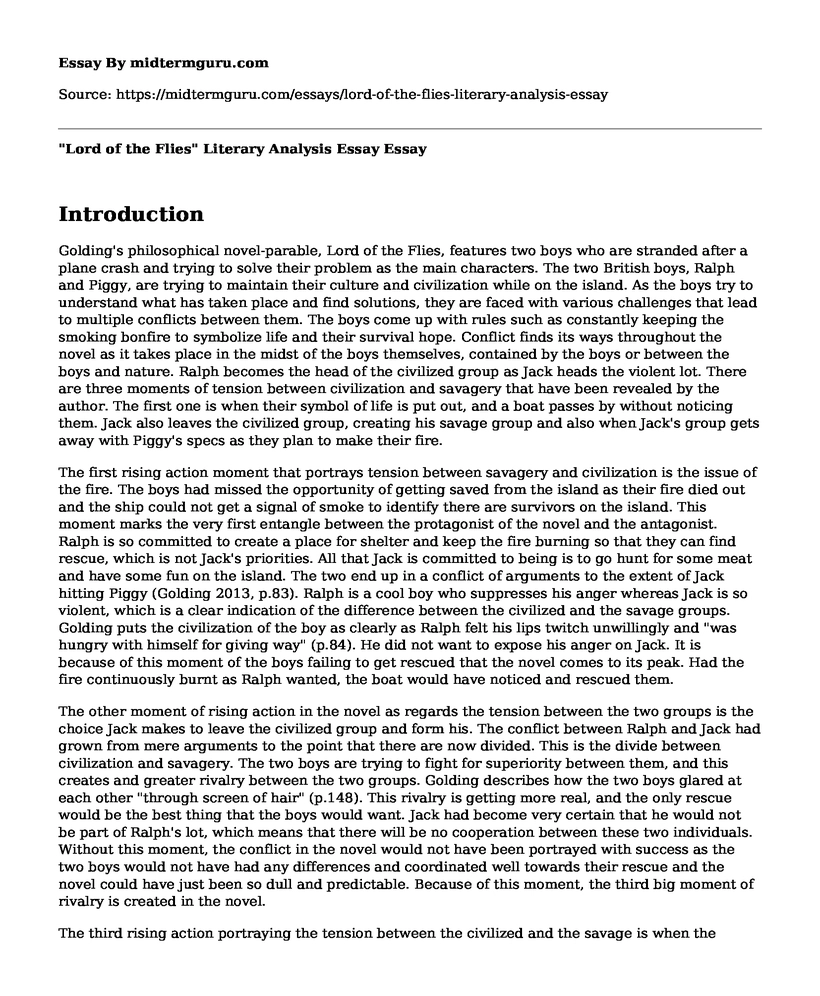Introduction
Golding's philosophical novel-parable, Lord of the Flies, features two boys who are stranded after a plane crash and trying to solve their problem as the main characters. The two British boys, Ralph and Piggy, are trying to maintain their culture and civilization while on the island. As the boys try to understand what has taken place and find solutions, they are faced with various challenges that lead to multiple conflicts between them. The boys come up with rules such as constantly keeping the smoking bonfire to symbolize life and their survival hope. Conflict finds its ways throughout the novel as it takes place in the midst of the boys themselves, contained by the boys or between the boys and nature. Ralph becomes the head of the civilized group as Jack heads the violent lot. There are three moments of tension between civilization and savagery that have been revealed by the author. The first one is when their symbol of life is put out, and a boat passes by without noticing them. Jack also leaves the civilized group, creating his savage group and also when Jack's group gets away with Piggy's specs as they plan to make their fire.
The first rising action moment that portrays tension between savagery and civilization is the issue of the fire. The boys had missed the opportunity of getting saved from the island as their fire died out and the ship could not get a signal of smoke to identify there are survivors on the island. This moment marks the very first entangle between the protagonist of the novel and the antagonist. Ralph is so committed to create a place for shelter and keep the fire burning so that they can find rescue, which is not Jack's priorities. All that Jack is committed to being is to go hunt for some meat and have some fun on the island. The two end up in a conflict of arguments to the extent of Jack hitting Piggy (Golding 2013, p.83). Ralph is a cool boy who suppresses his anger whereas Jack is so violent, which is a clear indication of the difference between the civilized and the savage groups. Golding puts the civilization of the boy as clearly as Ralph felt his lips twitch unwillingly and "was hungry with himself for giving way" (p.84). He did not want to expose his anger on Jack. It is because of this moment of the boys failing to get rescued that the novel comes to its peak. Had the fire continuously burnt as Ralph wanted, the boat would have noticed and rescued them.
The other moment of rising action in the novel as regards the tension between the two groups is the choice Jack makes to leave the civilized group and form his. The conflict between Ralph and Jack had grown from mere arguments to the point that there are now divided. This is the divide between civilization and savagery. The two boys are trying to fight for superiority between them, and this creates and greater rivalry between the two groups. Golding describes how the two boys glared at each other "through screen of hair" (p.148). This rivalry is getting more real, and the only rescue would be the best thing that the boys would want. Jack had become very certain that he would not be part of Ralph's lot, which means that there will be no cooperation between these two individuals. Without this moment, the conflict in the novel would not have been portrayed with success as the two boys would not have had any differences and coordinated well towards their rescue and the novel could have just been so dull and predictable. Because of this moment, the third big moment of rivalry is created in the novel.
The third rising action portraying the tension between the civilized and the savage is when the savage team steals Piggy's specs from their camp. The savage group is so much concerned about their meat, and all they wanted was to create some fire for their meat. Jack's group is revealing their savagery through their actions, which makes this moment very significant in the novel. The savages display their greed and their unwillingness to cooperate with the rival civilized group. It is obvious that the civilized group would have handled the situation more appropriately by borrowing the glasses rather than stealing. Golding uses this rising moment to make his climax even more interesting. The confrontation from the theft of the specs continues to reveal the rivalry and conflict between Jack and Ralph's group.
Conclusion
The author, Golding, has been successful in showing the conflict between the two groups using these three rising moments. The issues of the signal fire led to an argument between the two boys that led to Jacks break of bonds with Ralph. The second rising action where Jacks shows no cooperation and creates his group makes the story even more interesting and revealing the conflict. The third and final rising action indicates the true definition of the savage group through their savagery action of stealing.
Reference
Golding, W. (2013). Lord of the Flies. Cairo - Egypt: The Anglo-Egyptian Bookshop.
Cite this page
"Lord of the Flies" Literary Analysis Essay. (2022, Sep 06). Retrieved from https://midtermguru.com/essays/lord-of-the-flies-literary-analysis-essay
If you are the original author of this essay and no longer wish to have it published on the midtermguru.com website, please click below to request its removal:
- Robert Frosts Poems Analysis Example
- Essay on the Feminist Approach in the Yellow Wallpaper by Charlotte Perkins Gilman
- Short Story Thematic Analysis: The New Dress and Open Road Media - Literature Paper Example
- Essay on Edgar Allan Poes Cask of Amontillado and Poems (Gothic Lit Genre)
- Essay Example About Sylvia Plath
- Literary Analysis Essay on Theme of Struggling and Suffering in Poetry: Maya Angelou and Langston Hughes
- Critical Essay on Shakespeare's MacBeth







